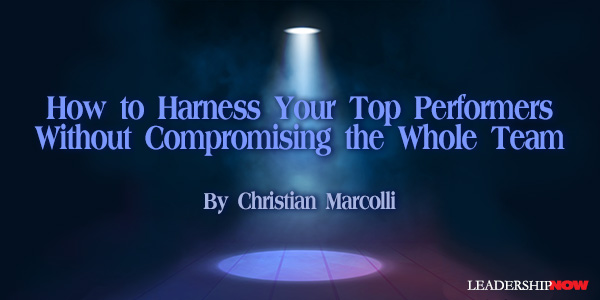 |
 |
12.13.24

How to Harness Your Top Performers Without Compromising the Whole Team
ONE OF the key questions for executives, business leaders, and entrepreneurs is how to keep raising the bar and ensure a continuous increase in your organization’s success year after year. To me, one of the biggest factors is how you specifically engage and develop your best performers — the ones who make a real difference. One of my clients, Richard, had a standout employee, Stella: at the top of her game, knowledgeable, driven, and skilled at connecting the dots. Hired for a key role in Richard’s organization, she quickly rose to a level of performance above many on her team. Therein lay the challenge. A Speedy Transformation Ruffles Some Feathers First, let’s take a look at Stella’s fast trajectory. She went through all four stages of her own evolution as a leader — what I call an Executive Performance Transformation — unusually fast:
Stella continued to shine, delivering top results confidently and consistently, embracing her own stretch goals, and role-modeling the company’s wider culture. She prioritized appropriately for overall success and was always willing to put in extra effort when needed. Richard saw the enormous value she added to the organization and increasingly involved her in the company’s strategic decision-making, asking for her input more often than he asked others. It was clear the whole business benefited from Stella’s ideas and achievements — even her team understood that. But she wasn’t always meshing with the team — and other sentiments began to surface as well among her colleagues, including resentment. Some of her fellow team members began to speak up, asking questions like: “Do Stella’s ideas and opinions count more than ours?” “Is Stella getting special treatment?” “Are we being outstripped by Stella?” Leveling the Team’s Imbalance As a leader, Richard had a dilemma. On the one hand, he needed to continue to reward and encourage Stella in order to go on harnessing her outstanding contribution. On the other hand, he needed to find a way to defuse her coworkers’ frustration and resentment and change the dynamic to prevent the team from becoming dysfunctional. In our coaching sessions, we discussed the best approach. It was clear he’d need to take care of both issues at the same time. We also went through some of the possible scenarios and unfavorable messages that he’d be sending out as a leader if he didn’t:
Parallel Strategies Embarking on his parallel approach, Richard started by regularly and explicitly expressing his appreciation and gratitude towards Stella for her exceptional attitude and performance. In this way, he avoided risking that she’d feel her efforts were taken for granted. In addition, he explained that he had the very highest expectations of her when it came to her team behavior. During their biweekly one-on-ones, he made sure to remind her that, as an exceptional performer, she had a major impact on those around her and would always be under intense scrutiny by other team members. Richard urged Stella to always act as a role model in every respect. In team meetings, for example, he advised her to contribute last, after her colleagues, to prevent them from feeling sidelined or railroaded. And before making her contribution, he suggested she first comment appreciatively on other members’ input: “You made a great point there...”, or “That reminded me of…” At the same time, Richard addressed the whole team. He organized an offsite session where he pointed out each member’s value to the overall success of the business. He particularly emphasized the team player qualities of each individual. Then he set up one-on-one meetings between every team member, including himself. After well-structured preparation, each team member shared what they valued, especially about the other, what the other could change to achieve even better teamwork, and how they could support each other even more. On the back of this process, each team member made one personal commitment that would add to the team’s strength. For his own one-on-one with each team member, Richard asked for direct and candid feedback, asking, “Does everybody feel equally appreciated?” “Does everybody get sufficient opportunity to contribute their ideas?” “Does everybody feel fully included?” Building a Culture of High Performance and Appreciation Richard’s approach enabled him to continue harnessing Stella’s exceptional performance and potential. At the same time, he established a high-performance culture built on mutual respect, appreciation and support. The challenge he faced is certainly not uncommon in organizations. As a leader, you may likely experience a similar situation. My recommendation is that you keep aiming high. Harness the exceptional potential of individual star performers while simultaneously cultivating a healthy team culture. It’s a win for everyone.  
Posted by Michael McKinney at 09:17 AM
|
BUILD YOUR KNOWLEDGE
 

How to Do Your Start-Up Right STRAIGHT TALK FOR START-UPS 
Grow Your Leadership Skills NEW AND UPCOMING LEADERSHIP BOOKS 
Leadership Minute BITE-SIZE CONCEPTS YOU CAN CHEW ON 
Classic Leadership Books BOOKS TO READ BEFORE YOU LEAD |